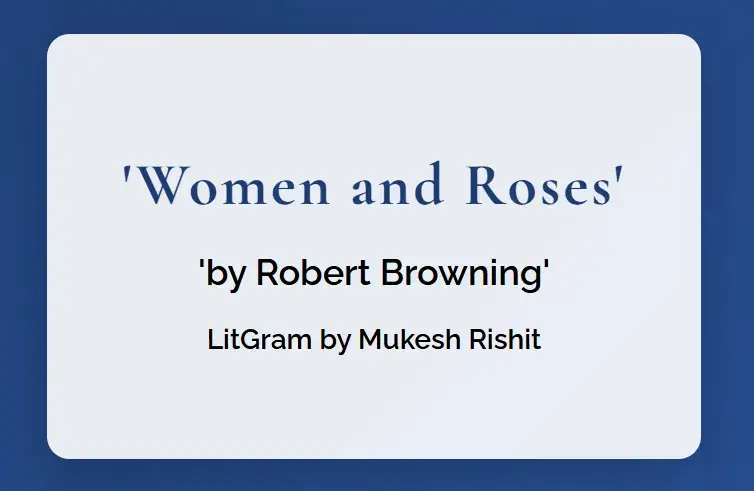Introduction
One of Robert Browning’s more enigmatic works, Women and Roses, takes readers on a journey through a dream landscape filled with roses and women symbolizing love, loss, and the passage of time. With its fleeting imagery, layered themes, and rhythmic musicality, the poem explores the interconnectedness of past, present, and future as it relates to both womanhood and desire. Through evocative language, Browning invites readers into a world where roses are not just flowers but stand as time-bound metaphors for the roles and experiences of women.
Table of Contents
The opening stanza immediately captivates with its dreamlike premise:
I dream of a red-rose tree.
And which of its roses three
Is the dearest rose to me?
This opening lines set the tone for the exploration of love and femininity through the symbolic “rose tree.”
The Poet Behind The Poem
Who Was Robert Browning?
Born in 1812, Robert Browning was one of the most innovative poets of the Victorian era. Known for his dramatic monologues and intellectual depth, much of his poetry (including Women and Roses) displays his fascination with eternal questions: love, mortality, and art. Browning’s relationship with his wife, Elizabeth Barrett Browning, shaped his work significantly, often inspiring themes of romantic idealism mixed with earthly struggles.
The themes in Women and Roses reflect not only Robert Browning’s personal experiences but also Victorian society’s evolving perspectives on art, time, and human passion.
Overview of the Poem
Robert Browning divides the poem into eight stanzas, each contributing to a layered narrative about women across time. The red-rose tree forms the central metaphor, symbolizing love, femininity, and the cyclical nature of life.
The recurring line:
They circle their rose on my rose tree,
acts as a refrain and unifies the poem’s exploration of women from the “antique time,” the present, and the elusive future.
Symbolism of the Rose Tree
The red-rose tree, central to the poem, serves as a nexus where all time periods meet. Each rose signifies a point in the temporal spectrum—past, present, and future:
Past: Women Sculpted in Marble
In the second stanza, Browning describes the women of the past, immortalized in art and literature:
Round and round, like a dance of snow
In a dazzling drift, as its guardians, go
Floating the women faded for ages,
Sculptured in stone, on the poet’s pages.
The image of ancient women encased in stone reflects the Victorian fascination with antiquity and the idea of preserving beauty and love as static ideals. They are “faded for ages,” distant and detached from the living world.
Present: Living and Loving
The women of the present are visceral and alive:
Then follow women fresh and gay,
Living and loving and loved to-day.
These women are in their prime, bringing forth the immediate passion and vibrancy of life. Browning contrasts their fleeting nature with the eternal stillness of the past, emphasizing the bittersweet qualities of youth and contemporary love.
Future: Unborn Beauty
Finally, the women of the future are:
Last, in the rear, flee the multitude of maidens,
Beauties yet unborn.
These women represent potential, possibility, and the promise of change. They remain abstract, like buds that have yet to blossom, offering a vision of hope and new beginnings.
An Eternal Cadence
Each stanza returns to the haunting refrain:
They circle their rose on my rose tree.
The repetition highlights the inevitability of time’s cyclical pattern. No matter the era, women and their symbolic roses are caught in the rhythm of life’s dance, eternally circling but ultimately elusive.
Themes in Women and Roses
Love and Transience
At its core, the poem examines the fleeting nature of beauty and love. In the third stanza, Browning mourns the passing of the rose (and, by extension, the passing of passion and vitality):
Dear rose, thy term is reached,
Thy leaf hangs loose and bleached:
Bees pass it unimpeached.
This recognition of decline underscores the temporal fragility of physical beauty and romantic attachment.
Immortal Longing
Although the women of the past are out of reach and those of the future remain unborn, Browning yearns to capture their essence. This desire is expressed in the fourth stanza:
How shall I fix you, fire you, freeze you,
Break my heart at your feet to please you?
The speaker’s longing extends beyond mere physical possession—he yearns to connect with eternity, to possess a love powerful enough to defy time itself.
Feminine Ideal Across Eras
The roses embody not just feminine beauty but also the evolving ideals of what it means to be a woman. While Victorian society often idealized women as passive objects, Browning complicates this by portraying his women as dynamic, active participants in the procession of time.
Imagery and Literary Devices
Imagery
Browning layers his poem with rich visual imagery:
- Snow Dance (Past Women): “Round and round, like a dance of snow…” evokes timelessness and cold distance.
- Blooming Rose (Present Women): “Thy cup is ruby-rimmed, / Thy cup’s heart nectar-brimmed” brings vibrancy to the present moment.
- Statue Imagery: “As drops from a statue’s plinth” captures longing and immobility, blending art and life.
Symbolism
- The Roses: Represent love, beauty, and time.
- The Bee: The bee sucking in nectar represents fleeting pleasures and the inevitability of loss.
- The Artist (Speaker): The speaker’s role mirrors that of a creator or observer, unable to fully bridge the gap between desire and reality.
Refrain
The refrain, “They circle their rose on my rose tree,” reinforces the cyclical and unattainable nature of the speaker’s desires, tying all temporal worlds together.
Interpretation of Key Stanzas
Stanza IV: The Struggle to Possess
The speaker laments his inability to possess or preserve the women of the past:
Stay then, stoop, since I cannot climb,
You, great shapes of the antique time!
This plea conveys both reverence and frustration, reflecting his profound longing for connection.
Stanza VI: A Moment of Passion
Here, the imagery becomes sensual and immediate:
Eyes in your eyes, lips on your lips!
Fold me fast where the cincture slips,
Prison all my soul in eternities of pleasure.
Passion reaches its peak as the speaker yearns for an intense and eternal connection. Yet, the refrain breaks the spell—reminding readers that this longing is cyclical and incomplete.
Stanza VIII: The Future’s Promise
The final stanza shifts to the future:
Roses will bloom nor want beholders,
Sprung from the dust where our flesh moulders.
This vision of cyclical rebirth captures the relentless march of time, even as it hints at the redemptive power of creation and renewal.
The Poem’s Conclusion: The Eternal Dance
Ultimately, Women and Roses emphasizes that the beauty of love and womanhood lies in its mystery and elusiveness. The speaker is caught in a dream where the women of all eras perpetually “circle their rose” on his symbolic rose tree. His longing remains unresolved—a reflection of the human condition.
FAQs About Women and Roses
- What is the central metaphor of the poem?
The red-rose tree symbolizes love, femininity, and the cycle of time encompassing past, present, and future. - Why does Browning use a recurring refrain?
The refrain, “They circle their rose on my rose tree,” emphasizes the cyclical and eternal nature of time and human desire. - What do the bees symbolize in stanza III?
The bees signify fleeting pleasures and the inevitability of life moving on, even as beauty fades. - What role does time play in the poem?
Time is a central theme, connecting past, present, and future through the recurring image of women and roses. - How does Women and Roses reflect Victorian values?
The poem reflects Victorian ideals of femininity while also challenging them through its nuanced portrayal of women across time.


